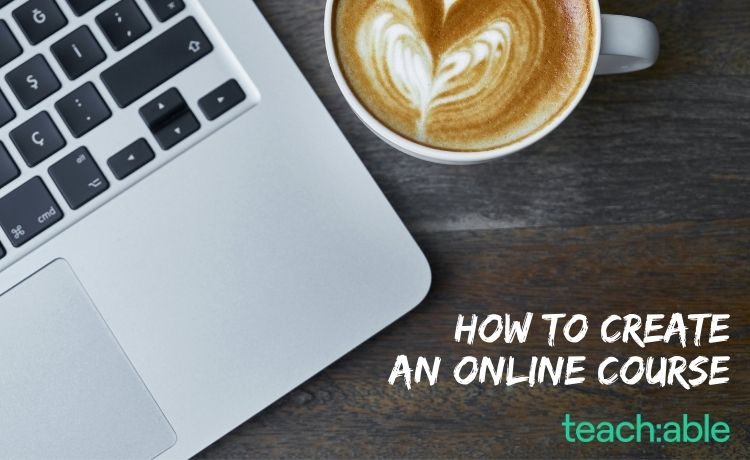An online course is a great way to create a passive income. In this article, we cover how to create an online course and give the ultimate tips to create your own online course, including the best platform you can choose for your online course.
Creating an online course is a great way to invest without having money in the bank. An online course is all about investing time. This will convert into passive income later on. If you consider making money online by sharing information on a subject you are interested in, this article is a great resource.
There are three main ingredients you need to have when you want to create your own online course:
- The subject or topic for your online course,
- Time to create the online course, and
- A course outline to get you started
Next to that, you will also need to choose the platform to host your online course. After researching the options for our Design Your Financial Freedom Toolkit, we choose the Teachable platform. We will explain the reasons for our choice as well.
 What is a good course subject?
What is a good course subject?
The first step is you have to decide on the topic or subject for your online course.
One misunderstanding when it comes to the topic or subject of your online course is that it has to be something you are an expert in. This just isn’t true although it is probably one of the main reasons why people do not create an online course.
Your course should be about something you do that distinguishes you from others. That doesn’t mean that you have to be an expert. It just means that you have to pick a subject that’s more unique about you.
The fact of the matter is that knowledge just isn’t that interesting anymore. There is already so much information available online. You are better off adding value by sharing your approach, your style, and your ideas to a specific subject or topic.
Focus on what makes you different, whether it is your approach to designing websites, the trick you have to create mindfulness, or the workout schedule you created for yourself. As long it is about how YOU do something, you are always your own expert.
Time to create your online course
Once you have picked a subject for your course, you need time to make the course. This time will be spent mainly on writing the contents of the course, such as the text, recording and editing the videos, making a slide deck, creating assignments and quizzes, etc.
But there will also be the time needed to create a sales page in which you explain the course to people that might be interested. And of course, you need to include time to investigate the best platform or software to create online training courses (more on that later)
It is best to assign special time slots in your agenda to dedicate to working on your new course. Decide how much time you can invest and put down a big red cross in your agenda when you are going to invest the time.
Create an online course outline
A course outline is a structure that consists of all the sub-topics that are part of your course. What is the information you want to be in your course? And in what order?

Having a course outline ensures that you include all relevant information in your course, and it helps you to structure your course content. You just write down all the topics that should be in the course and shuffle them in the right order.
Once you have your structure, the actual creation of the course is much easier. A good course outline allows you to work on each sub-topic separately. That way, what seemed like a huge task before, turns into smaller sections to work on.
Tips when creating an online course
Next to our tips on the choice for your course subject and the way you can best work on your course, there are two other important tips we want to give you:
- Decide on the goal and target group first: What value do you want to deliver? And to whom? You need to start with this because it will determine the set-up of the complete course. It is wise to think about the end goal, but also about subgoals such as the knowledge, the attitude, and the behavioral change you want to bring about
- Reserve time to test your course: Before we launched our Design Your Financial Freedom Toolkit, we offered a few people out of our target group free access in return for their honest opinion. Of course, they will need time to go through the course and you will need to make changes afterward. However, it is totally worth it! It is so valuable to get first-hand feedback and to be able to get the first issues resolved before you start selling.
What is the best online course platform?
Choosing the right platform for your online course is important. There are quite a few options to host your online course. And the last thing you want is to put the complete course online only to found out that you don’t like it after all. Switching to another platform at that point is just annoying.
When considering which course platform is the best for your online course, there are a few things to look at. Price, look and feel, and functionality are important factors to investigate. However, depending on your level of comfort with online tools, (technical) support might be important as well.
When we looked at possible platforms to host our online course, we wanted a platform that matched the level of professionality of our blog. We felt it was important to work with a platform that a lot of other professionals chose as well when it came to their online courses.

Online course platform comparison
In our comparison, we looked at the online course platforms Udemy, Skillshare, Thinkific, and Teachable.
Thinkific was rather new to the market. Udemy’s look and feel didn’t appeal to us that much. Besides, we also felt it was more focused on concrete skills, which didn’t fit our profile. This was also the case with Skillshare.
Investigating a bit more in our network, all the people we follow and value, used Teachable for their online course. We also noticed that they did so for a very long time already. That, combined with the positive experience we had from the look and feel and functionality, made us decided to go with Teachable.
Many platforms offer a free trial, which is great because it will allow you to play around with the platform to discover the way it works. Teachable has a 14-day free trial in which you can start creating your course to discover the way it works.
How much does it cost to develop an online course?
The great thing about starting an online course for passive income is that you only have to invest your own time. You do not need a lot of money to make it happen, and therefore the cost to develop an online course can be pretty low.
You only need an internet connection a computer and access to the Teachable platform. If you want to go more professional, you could add professionally shot videos, custom visuals, and so on, but really you can just as easily start by recording yourself on your phone or using a web tool such as Loom. If you want to add nice images and visuals, we definitely recommend using Pexels.com for free stock images and Canva.com to create visual designs. Both websites are totally free.
With your online course, it is smart to start small, for instance with a (shorter) introduction pilot course, and build from that. That way, you don’t have to invest tons of time while you still have to test whether people are interested in what you have to offer and willing to purchase it.
If you don’t take into consideration the time you invest, creating an online course will costs you almost nothing. You only pay a small monthly fee for the Teachable platform (after the 14-day free trial) and that’s it. Only when you start selling your online course, Teachable will take a fee from each course sold. That way you do not really have a financial risk, which is great when you start!
Your online course is an asset
An important factor in your journey towards financial freedom is the step of creating and growing assets. An asset is something that you invest in in the long-term and that can make you money in the short-term.

Depending on the type of asset, your asset can give you a passive income. This means that as long as you keep your money invested in the asset, the asset generates an income. Preferable an income that you don’t need to exchange much time for. That way you have the freedom to spend your day the way you want, without being stuck in a 9-to-5 job.
A real-estate-rental property is a great example of an asset that creates passive income. But there are also a lot of other opportunities as well.
Related: Passive income ideas for 2021
One of the big advantages of an online course is that you create it by investing time, not money. This lowers the barrier to acquire the asset since you do need any savings in the bank or a loan to finance the asset.
How do you teach online courses and make passive income?
Let’s assume that you have successfully created your online course. You are ready to get the money rolling into your bank account now. Time to sit back and relax, right?
Wrong! Creating an online course is one thing. But transforming that course into a real asset that generates a monthly passive income is a totally different ballgame.
If you want to make money with your online course, you need to figure out how to:
- reach the right people for your course
- inform them about the value of your course and
- sell more courses than the monthly costs of the platform
To start with the last issue: the monthly costs of the Teachable platform are very low. This means you will probably be able to start making a passive income if you only sell one course each month. So, you don’t really have to worry about that one.
How to get students for your online course?
The main thing is to inform the right people about your online course and to show them what value the course has to offer. If you want to work towards passive income, you will need to find a way to automize this system. Otherwise, it will be active income, meaning you are actively putting in hours to create the result.

First of all, you need to make a good sales page for your online course. One that is appealing to your target group and informs them about the value of your course. But no matter how good your sales page is, often people need some extra time to think about what you have to offer. They may want to get to know you a bit better. And they might more information about the value they will get from your course.
A very good way to deal with this is by working with an email list. An email list is a list of people that are interesting in the subject of your course. By using mail list tools, such as Convertkit you can automate the growth of your potential course participants. You can send them a sequence of emails in which you introduce yourself and pitch your online course in more detail.
You can get new people on your email list by giving away a freebie, such as a guide, an e-book, or a free webinar. Anything goes, as long as you provide real value with it.
Conclusion
Hope this article gave you lots of info on how to create an online course. Maybe you are thinking of a subject for your online course already? Or you can draft a sample course outline for yourself? Just go to the Teachable platform and start today!
As suggested above we think that starting with a small online pilot course is accessible for everyone. You only have to invest time to make your online course a success. Creating your own online course is a great addition to your asset portfolio.


 What is a good course subject?
What is a good course subject?


